NUR250 Assessment 1 Project: Patient Care Plan and Medication
VerifiedAdded on 2020/11/23
|14
|3193
|348
Project
AI Summary
This NUR250 project presents a comprehensive patient care plan for David Parker, admitted for myocardial infarction. The project begins with a detailed patient assessment, including vital signs and specific nursing assessments for imbalanced fluid volume, impaired gas exchange, and activity intolerance. It then develops a nursing care plan addressing these problems, outlining goals, nursing interventions, and rationales, with indicators to measure the plan's effectiveness. The care plan includes interventions like fluid restriction, positioning for optimal gas exchange, and activity management. Finally, the project covers medication management, detailing the use of Frusemide and Digoxin, including their purposes, dosages, and nursing responsibilities related to their administration and patient monitoring. The project emphasizes the importance of lifestyle modifications and a caring environment to support the patient's recovery and improve their quality of life.
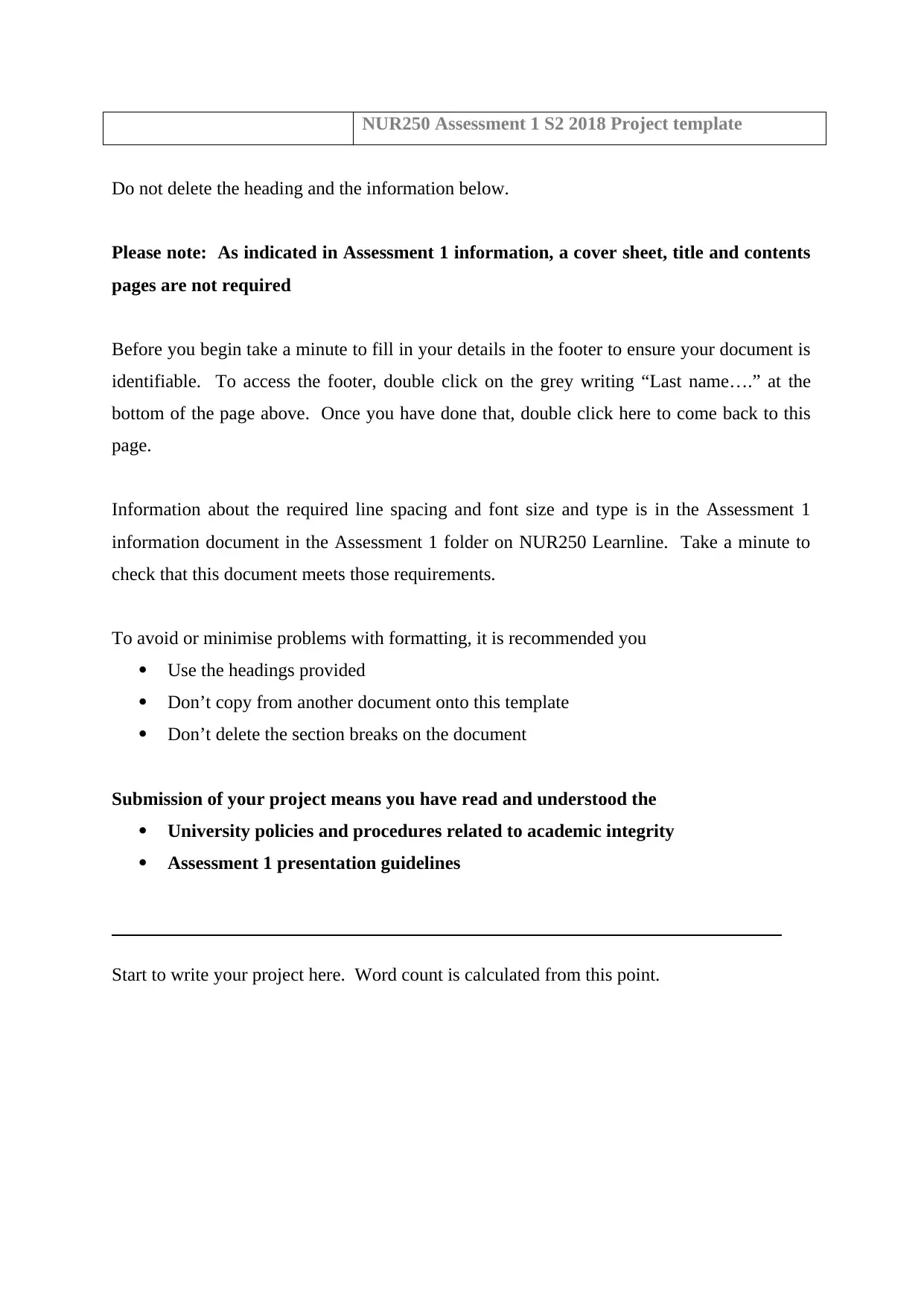
NUR250 Assessment 1 S2 2018 Project template
Do not delete the heading and the information below.
Please note: As indicated in Assessment 1 information, a cover sheet, title and contents
pages are not required
Before you begin take a minute to fill in your details in the footer to ensure your document is
identifiable. To access the footer, double click on the grey writing “Last name….” at the
bottom of the page above. Once you have done that, double click here to come back to this
page.
Information about the required line spacing and font size and type is in the Assessment 1
information document in the Assessment 1 folder on NUR250 Learnline. Take a minute to
check that this document meets those requirements.
To avoid or minimise problems with formatting, it is recommended you
Use the headings provided
Don’t copy from another document onto this template
Don’t delete the section breaks on the document
Submission of your project means you have read and understood the
University policies and procedures related to academic integrity
Assessment 1 presentation guidelines
Start to write your project here. Word count is calculated from this point.
Do not delete the heading and the information below.
Please note: As indicated in Assessment 1 information, a cover sheet, title and contents
pages are not required
Before you begin take a minute to fill in your details in the footer to ensure your document is
identifiable. To access the footer, double click on the grey writing “Last name….” at the
bottom of the page above. Once you have done that, double click here to come back to this
page.
Information about the required line spacing and font size and type is in the Assessment 1
information document in the Assessment 1 folder on NUR250 Learnline. Take a minute to
check that this document meets those requirements.
To avoid or minimise problems with formatting, it is recommended you
Use the headings provided
Don’t copy from another document onto this template
Don’t delete the section breaks on the document
Submission of your project means you have read and understood the
University policies and procedures related to academic integrity
Assessment 1 presentation guidelines
Start to write your project here. Word count is calculated from this point.
Paraphrase This Document
Need a fresh take? Get an instant paraphrase of this document with our AI Paraphraser
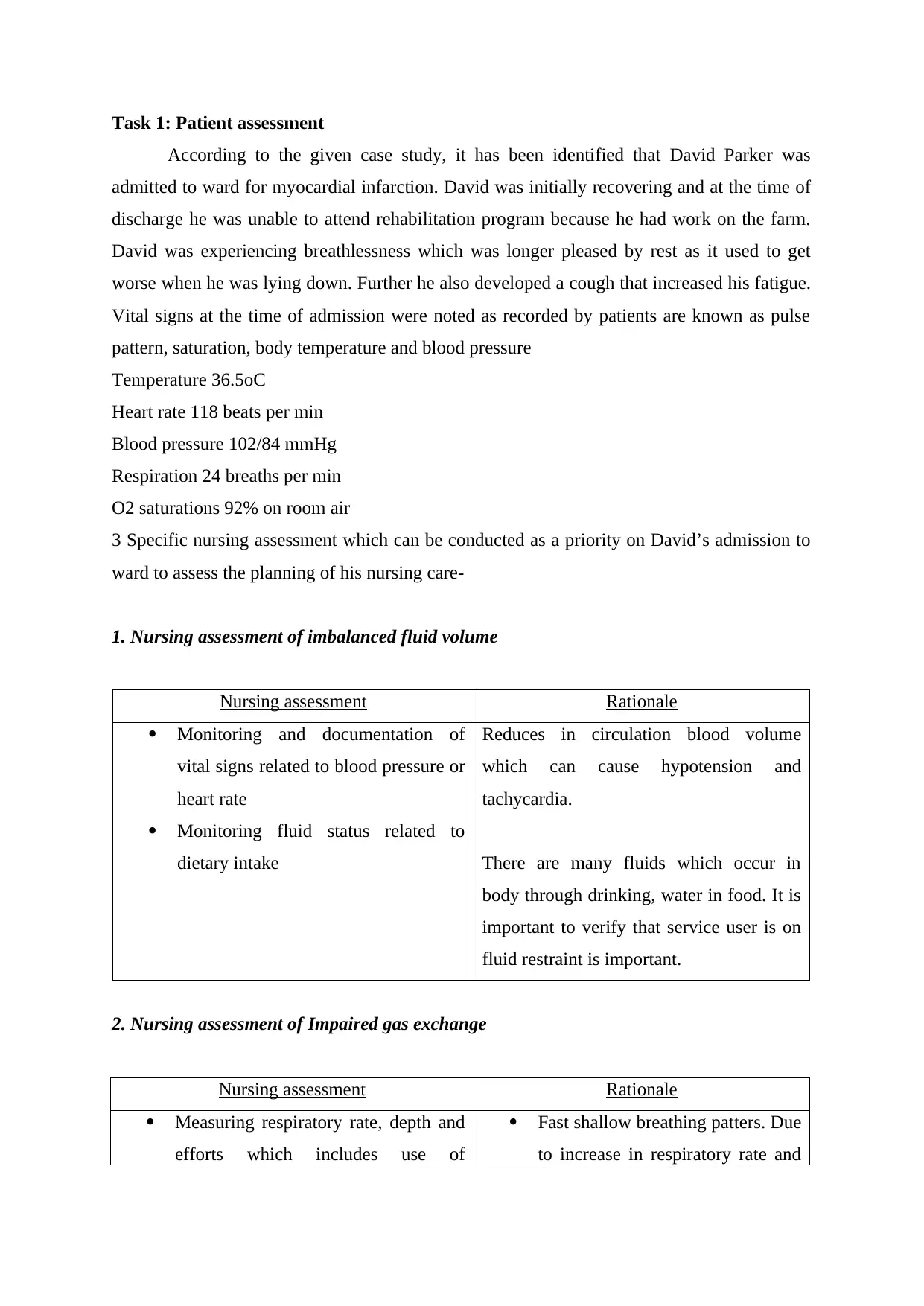
Task 1: Patient assessment
According to the given case study, it has been identified that David Parker was
admitted to ward for myocardial infarction. David was initially recovering and at the time of
discharge he was unable to attend rehabilitation program because he had work on the farm.
David was experiencing breathlessness which was longer pleased by rest as it used to get
worse when he was lying down. Further he also developed a cough that increased his fatigue.
Vital signs at the time of admission were noted as recorded by patients are known as pulse
pattern, saturation, body temperature and blood pressure
Temperature 36.5oC
Heart rate 118 beats per min
Blood pressure 102/84 mmHg
Respiration 24 breaths per min
O2 saturations 92% on room air
3 Specific nursing assessment which can be conducted as a priority on David’s admission to
ward to assess the planning of his nursing care-
1. Nursing assessment of imbalanced fluid volume
Nursing assessment Rationale
Monitoring and documentation of
vital signs related to blood pressure or
heart rate
Monitoring fluid status related to
dietary intake
Reduces in circulation blood volume
which can cause hypotension and
tachycardia.
There are many fluids which occur in
body through drinking, water in food. It is
important to verify that service user is on
fluid restraint is important.
2. Nursing assessment of Impaired gas exchange
Nursing assessment Rationale
Measuring respiratory rate, depth and
efforts which includes use of
Fast shallow breathing patters. Due
to increase in respiratory rate and
According to the given case study, it has been identified that David Parker was
admitted to ward for myocardial infarction. David was initially recovering and at the time of
discharge he was unable to attend rehabilitation program because he had work on the farm.
David was experiencing breathlessness which was longer pleased by rest as it used to get
worse when he was lying down. Further he also developed a cough that increased his fatigue.
Vital signs at the time of admission were noted as recorded by patients are known as pulse
pattern, saturation, body temperature and blood pressure
Temperature 36.5oC
Heart rate 118 beats per min
Blood pressure 102/84 mmHg
Respiration 24 breaths per min
O2 saturations 92% on room air
3 Specific nursing assessment which can be conducted as a priority on David’s admission to
ward to assess the planning of his nursing care-
1. Nursing assessment of imbalanced fluid volume
Nursing assessment Rationale
Monitoring and documentation of
vital signs related to blood pressure or
heart rate
Monitoring fluid status related to
dietary intake
Reduces in circulation blood volume
which can cause hypotension and
tachycardia.
There are many fluids which occur in
body through drinking, water in food. It is
important to verify that service user is on
fluid restraint is important.
2. Nursing assessment of Impaired gas exchange
Nursing assessment Rationale
Measuring respiratory rate, depth and
efforts which includes use of
Fast shallow breathing patters. Due
to increase in respiratory rate and
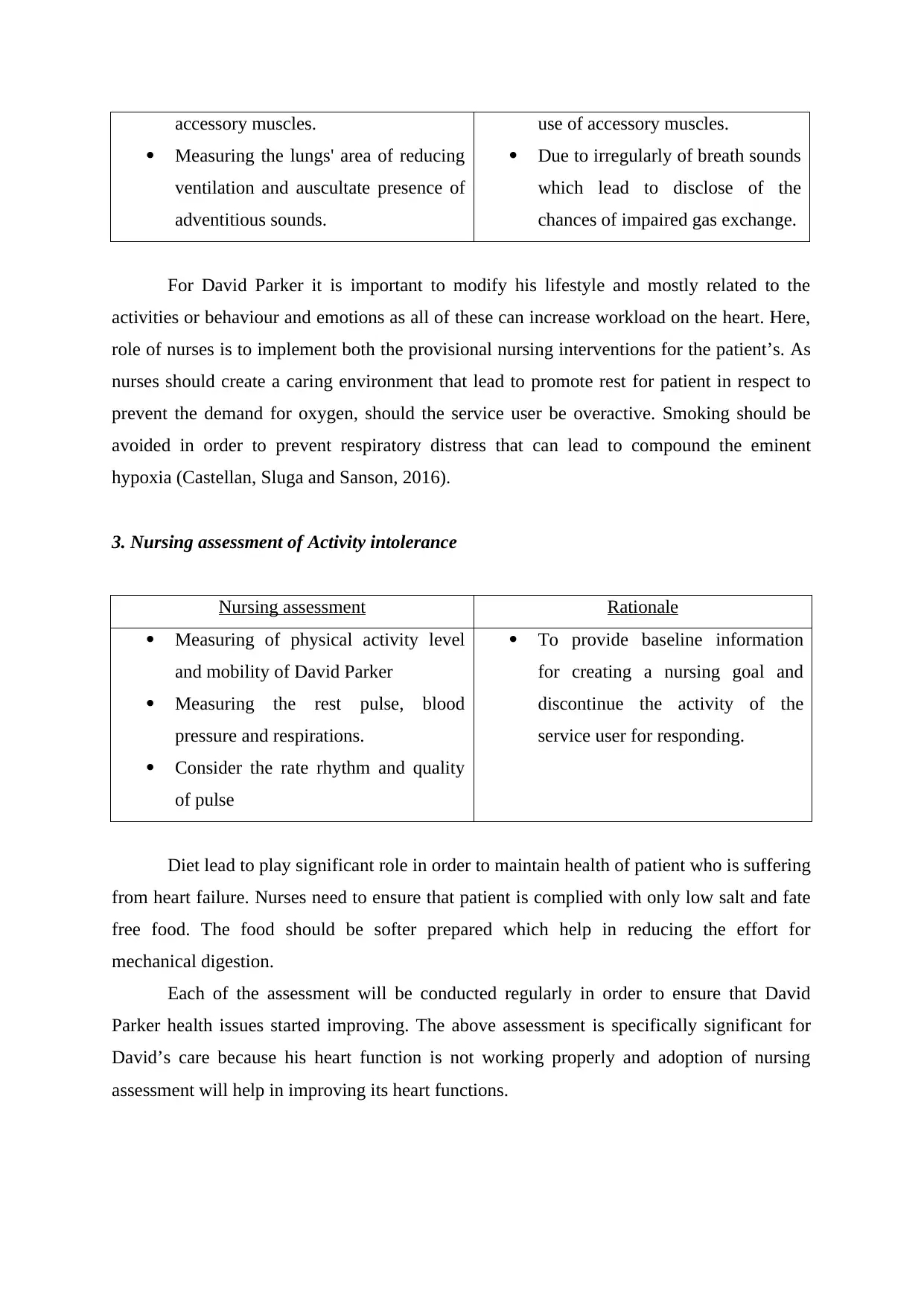
accessory muscles.
Measuring the lungs' area of reducing
ventilation and auscultate presence of
adventitious sounds.
use of accessory muscles.
Due to irregularly of breath sounds
which lead to disclose of the
chances of impaired gas exchange.
For David Parker it is important to modify his lifestyle and mostly related to the
activities or behaviour and emotions as all of these can increase workload on the heart. Here,
role of nurses is to implement both the provisional nursing interventions for the patient’s. As
nurses should create a caring environment that lead to promote rest for patient in respect to
prevent the demand for oxygen, should the service user be overactive. Smoking should be
avoided in order to prevent respiratory distress that can lead to compound the eminent
hypoxia (Castellan, Sluga and Sanson, 2016).
3. Nursing assessment of Activity intolerance
Nursing assessment Rationale
Measuring of physical activity level
and mobility of David Parker
Measuring the rest pulse, blood
pressure and respirations.
Consider the rate rhythm and quality
of pulse
To provide baseline information
for creating a nursing goal and
discontinue the activity of the
service user for responding.
Diet lead to play significant role in order to maintain health of patient who is suffering
from heart failure. Nurses need to ensure that patient is complied with only low salt and fate
free food. The food should be softer prepared which help in reducing the effort for
mechanical digestion.
Each of the assessment will be conducted regularly in order to ensure that David
Parker health issues started improving. The above assessment is specifically significant for
David’s care because his heart function is not working properly and adoption of nursing
assessment will help in improving its heart functions.
Measuring the lungs' area of reducing
ventilation and auscultate presence of
adventitious sounds.
use of accessory muscles.
Due to irregularly of breath sounds
which lead to disclose of the
chances of impaired gas exchange.
For David Parker it is important to modify his lifestyle and mostly related to the
activities or behaviour and emotions as all of these can increase workload on the heart. Here,
role of nurses is to implement both the provisional nursing interventions for the patient’s. As
nurses should create a caring environment that lead to promote rest for patient in respect to
prevent the demand for oxygen, should the service user be overactive. Smoking should be
avoided in order to prevent respiratory distress that can lead to compound the eminent
hypoxia (Castellan, Sluga and Sanson, 2016).
3. Nursing assessment of Activity intolerance
Nursing assessment Rationale
Measuring of physical activity level
and mobility of David Parker
Measuring the rest pulse, blood
pressure and respirations.
Consider the rate rhythm and quality
of pulse
To provide baseline information
for creating a nursing goal and
discontinue the activity of the
service user for responding.
Diet lead to play significant role in order to maintain health of patient who is suffering
from heart failure. Nurses need to ensure that patient is complied with only low salt and fate
free food. The food should be softer prepared which help in reducing the effort for
mechanical digestion.
Each of the assessment will be conducted regularly in order to ensure that David
Parker health issues started improving. The above assessment is specifically significant for
David’s care because his heart function is not working properly and adoption of nursing
assessment will help in improving its heart functions.
⊘ This is a preview!⊘
Do you want full access?
Subscribe today to unlock all pages.

Trusted by 1+ million students worldwide

Paraphrase This Document
Need a fresh take? Get an instant paraphrase of this document with our AI Paraphraser
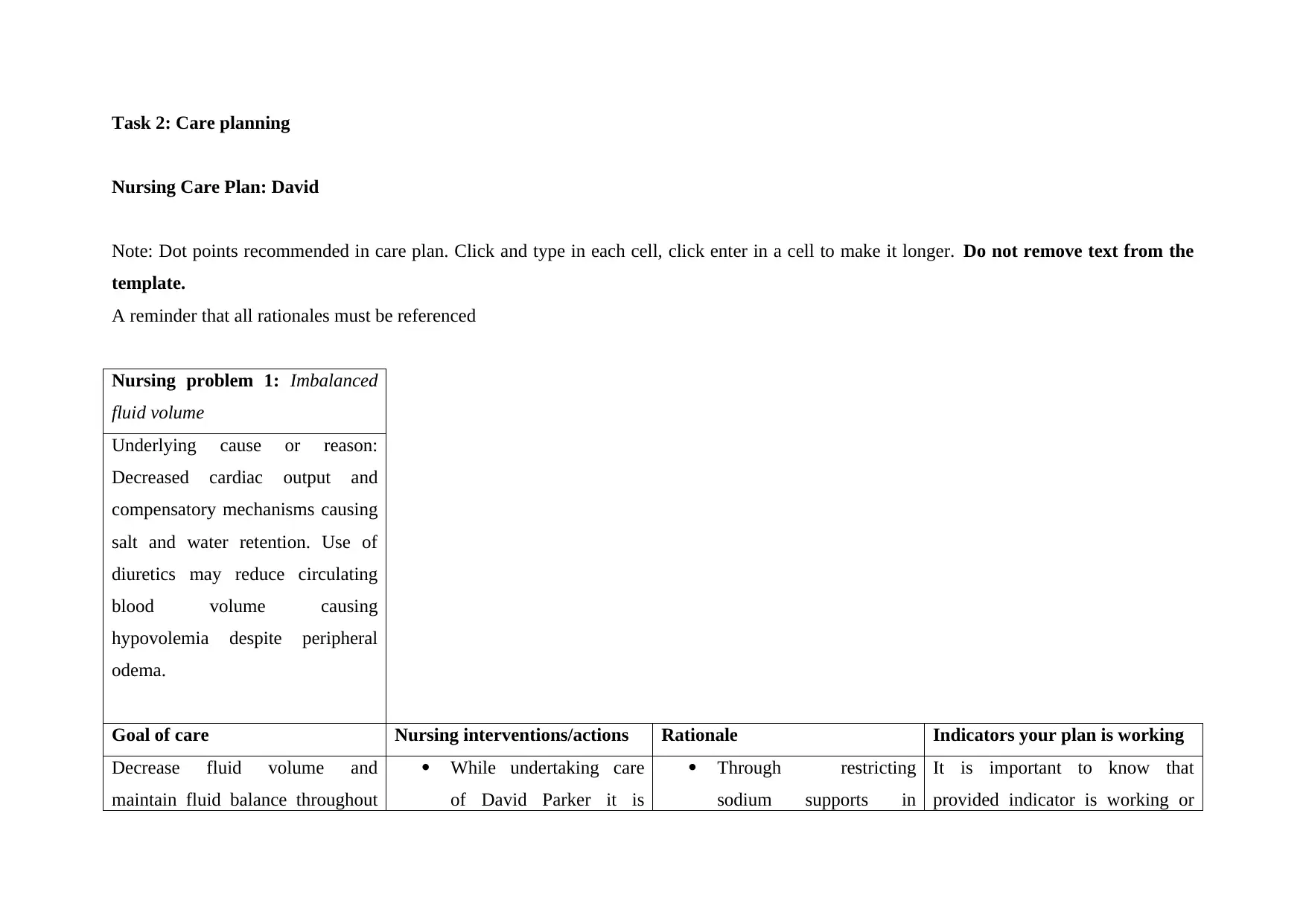
Task 2: Care planning
Nursing Care Plan: David
Note: Dot points recommended in care plan. Click and type in each cell, click enter in a cell to make it longer. Do not remove text from the
template.
A reminder that all rationales must be referenced
Nursing problem 1: Imbalanced
fluid volume
Underlying cause or reason:
Decreased cardiac output and
compensatory mechanisms causing
salt and water retention. Use of
diuretics may reduce circulating
blood volume causing
hypovolemia despite peripheral
odema.
Goal of care Nursing interventions/actions Rationale Indicators your plan is working
Decrease fluid volume and
maintain fluid balance throughout
While undertaking care
of David Parker it is
Through restricting
sodium supports in
It is important to know that
provided indicator is working or
Nursing Care Plan: David
Note: Dot points recommended in care plan. Click and type in each cell, click enter in a cell to make it longer. Do not remove text from the
template.
A reminder that all rationales must be referenced
Nursing problem 1: Imbalanced
fluid volume
Underlying cause or reason:
Decreased cardiac output and
compensatory mechanisms causing
salt and water retention. Use of
diuretics may reduce circulating
blood volume causing
hypovolemia despite peripheral
odema.
Goal of care Nursing interventions/actions Rationale Indicators your plan is working
Decrease fluid volume and
maintain fluid balance throughout
While undertaking care
of David Parker it is
Through restricting
sodium supports in
It is important to know that
provided indicator is working or
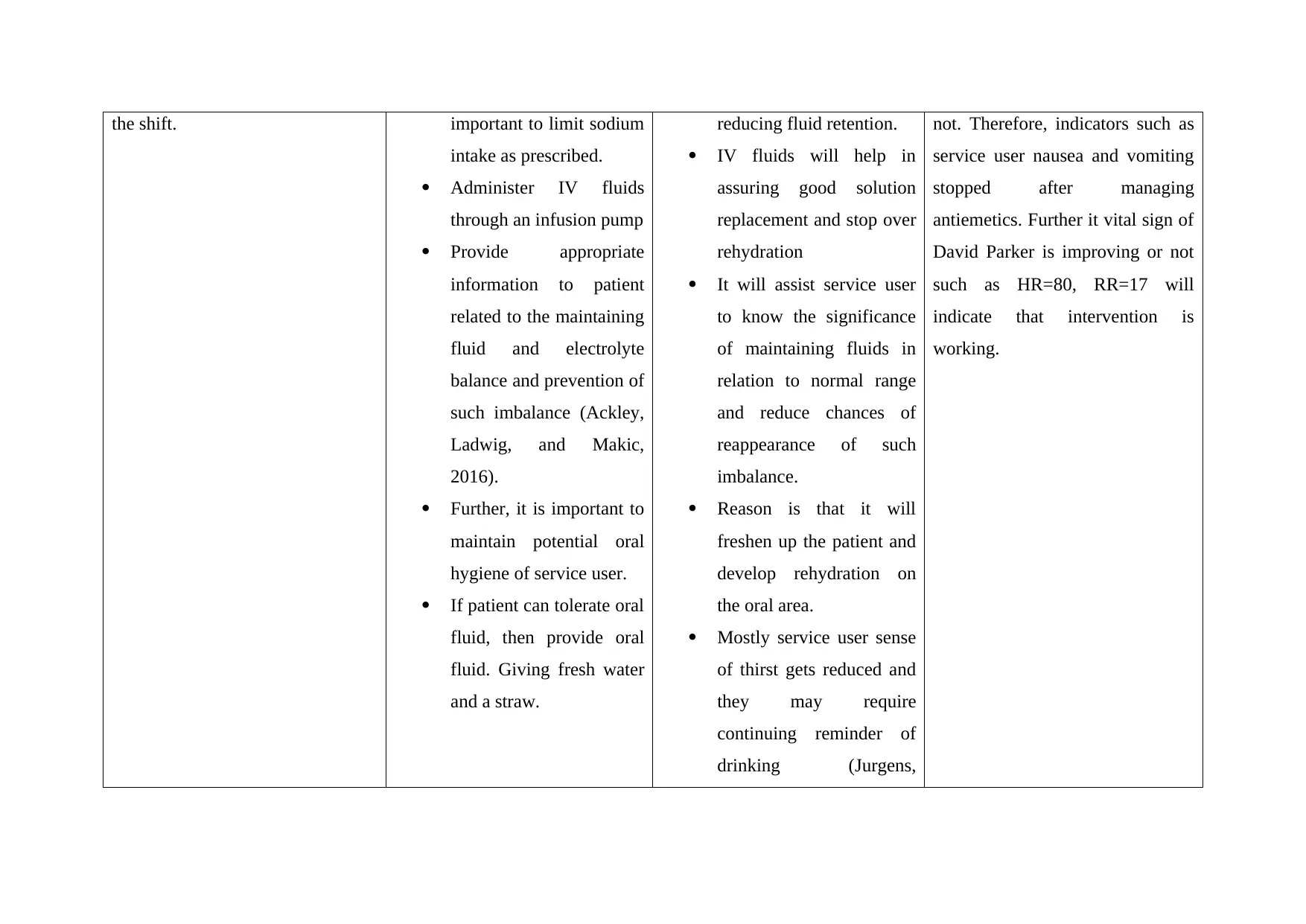
the shift. important to limit sodium
intake as prescribed.
Administer IV fluids
through an infusion pump
Provide appropriate
information to patient
related to the maintaining
fluid and electrolyte
balance and prevention of
such imbalance (Ackley,
Ladwig, and Makic,
2016).
Further, it is important to
maintain potential oral
hygiene of service user.
If patient can tolerate oral
fluid, then provide oral
fluid. Giving fresh water
and a straw.
reducing fluid retention.
IV fluids will help in
assuring good solution
replacement and stop over
rehydration
It will assist service user
to know the significance
of maintaining fluids in
relation to normal range
and reduce chances of
reappearance of such
imbalance.
Reason is that it will
freshen up the patient and
develop rehydration on
the oral area.
Mostly service user sense
of thirst gets reduced and
they may require
continuing reminder of
drinking (Jurgens,
not. Therefore, indicators such as
service user nausea and vomiting
stopped after managing
antiemetics. Further it vital sign of
David Parker is improving or not
such as HR=80, RR=17 will
indicate that intervention is
working.
intake as prescribed.
Administer IV fluids
through an infusion pump
Provide appropriate
information to patient
related to the maintaining
fluid and electrolyte
balance and prevention of
such imbalance (Ackley,
Ladwig, and Makic,
2016).
Further, it is important to
maintain potential oral
hygiene of service user.
If patient can tolerate oral
fluid, then provide oral
fluid. Giving fresh water
and a straw.
reducing fluid retention.
IV fluids will help in
assuring good solution
replacement and stop over
rehydration
It will assist service user
to know the significance
of maintaining fluids in
relation to normal range
and reduce chances of
reappearance of such
imbalance.
Reason is that it will
freshen up the patient and
develop rehydration on
the oral area.
Mostly service user sense
of thirst gets reduced and
they may require
continuing reminder of
drinking (Jurgens,
not. Therefore, indicators such as
service user nausea and vomiting
stopped after managing
antiemetics. Further it vital sign of
David Parker is improving or not
such as HR=80, RR=17 will
indicate that intervention is
working.
⊘ This is a preview!⊘
Do you want full access?
Subscribe today to unlock all pages.

Trusted by 1+ million students worldwide
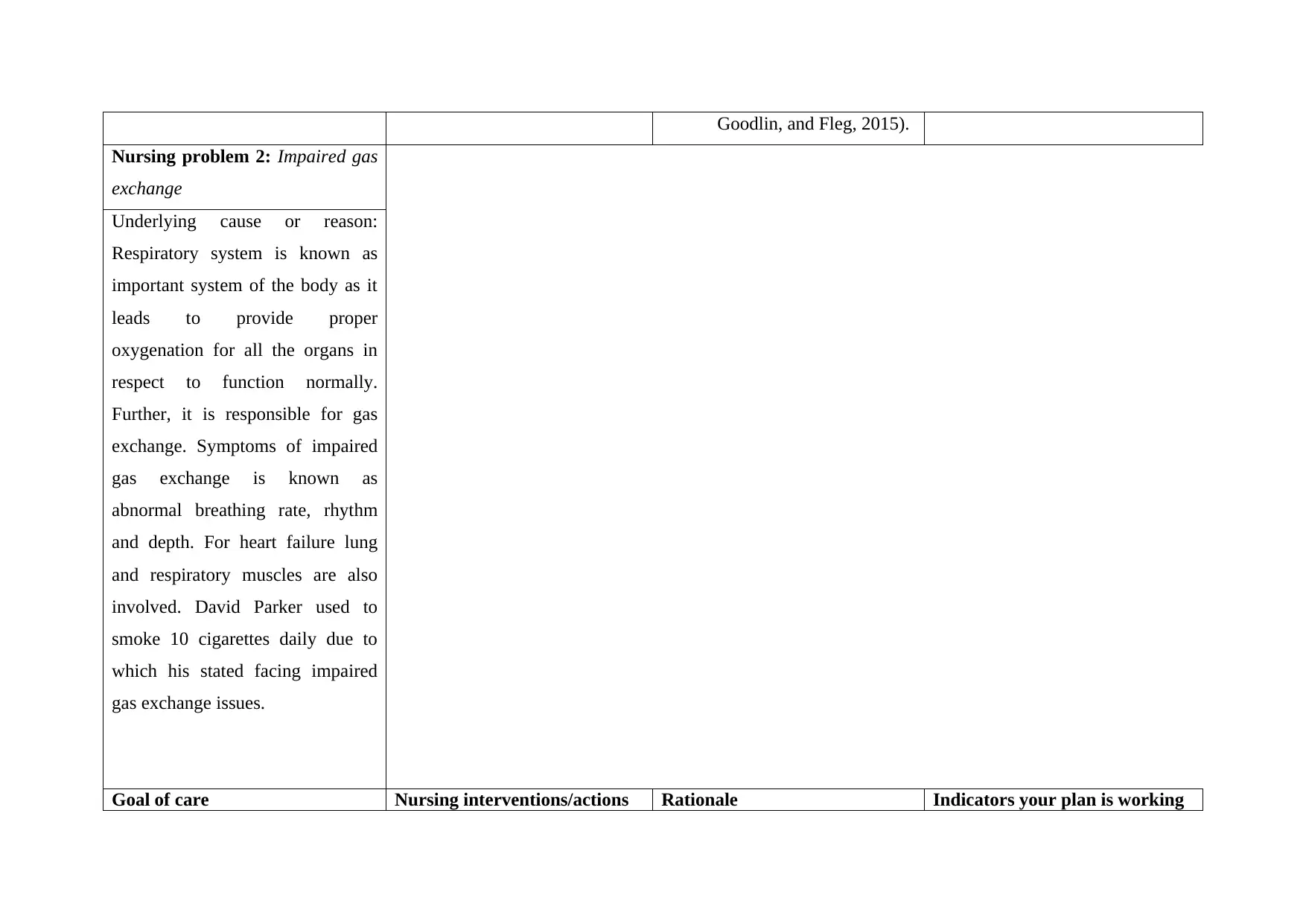
Goodlin, and Fleg, 2015).
Nursing problem 2: Impaired gas
exchange
Underlying cause or reason:
Respiratory system is known as
important system of the body as it
leads to provide proper
oxygenation for all the organs in
respect to function normally.
Further, it is responsible for gas
exchange. Symptoms of impaired
gas exchange is known as
abnormal breathing rate, rhythm
and depth. For heart failure lung
and respiratory muscles are also
involved. David Parker used to
smoke 10 cigarettes daily due to
which his stated facing impaired
gas exchange issues.
Goal of care Nursing interventions/actions Rationale Indicators your plan is working
Nursing problem 2: Impaired gas
exchange
Underlying cause or reason:
Respiratory system is known as
important system of the body as it
leads to provide proper
oxygenation for all the organs in
respect to function normally.
Further, it is responsible for gas
exchange. Symptoms of impaired
gas exchange is known as
abnormal breathing rate, rhythm
and depth. For heart failure lung
and respiratory muscles are also
involved. David Parker used to
smoke 10 cigarettes daily due to
which his stated facing impaired
gas exchange issues.
Goal of care Nursing interventions/actions Rationale Indicators your plan is working
Paraphrase This Document
Need a fresh take? Get an instant paraphrase of this document with our AI Paraphraser
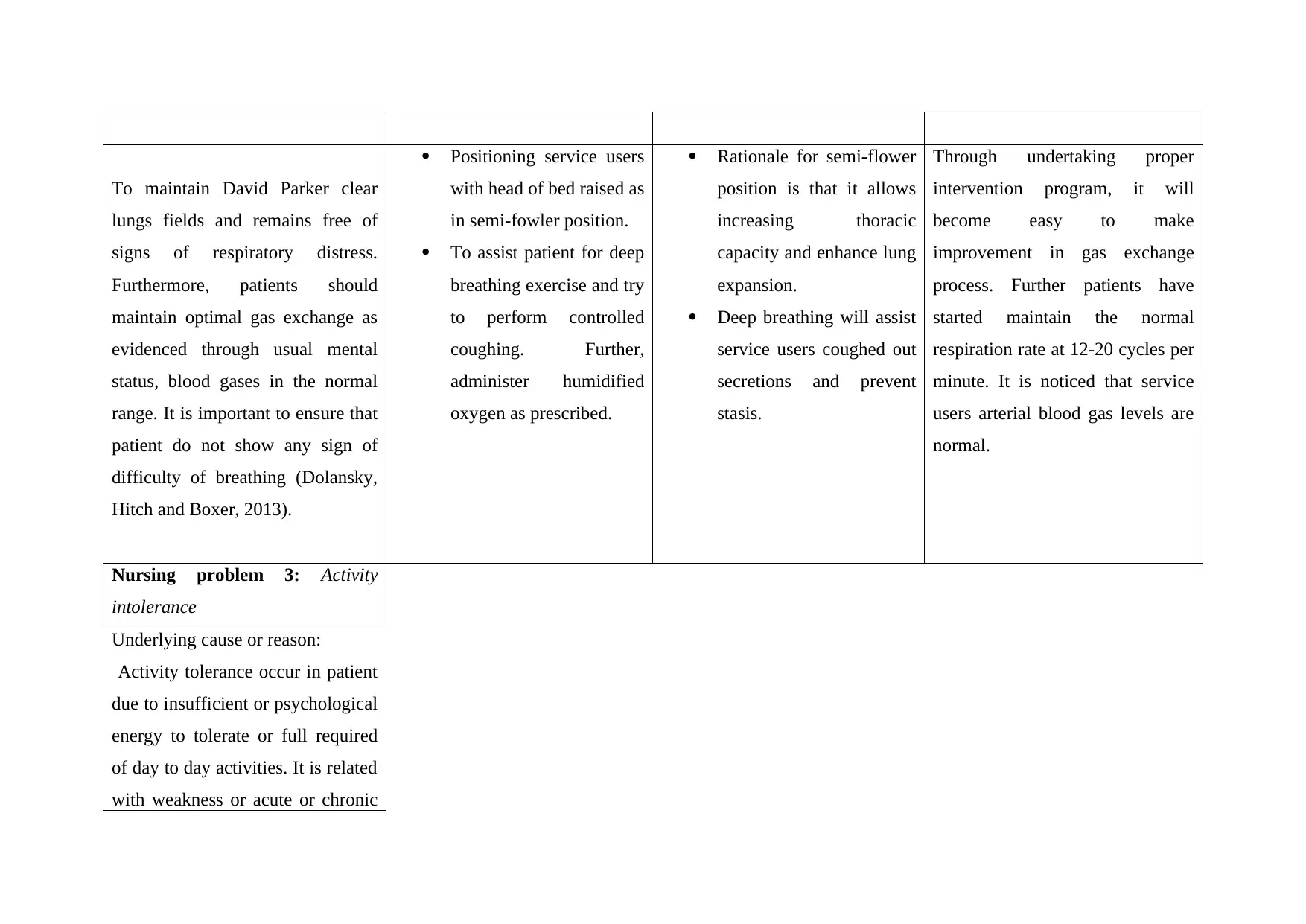
To maintain David Parker clear
lungs fields and remains free of
signs of respiratory distress.
Furthermore, patients should
maintain optimal gas exchange as
evidenced through usual mental
status, blood gases in the normal
range. It is important to ensure that
patient do not show any sign of
difficulty of breathing (Dolansky,
Hitch and Boxer, 2013).
Positioning service users
with head of bed raised as
in semi-fowler position.
To assist patient for deep
breathing exercise and try
to perform controlled
coughing. Further,
administer humidified
oxygen as prescribed.
Rationale for semi-flower
position is that it allows
increasing thoracic
capacity and enhance lung
expansion.
Deep breathing will assist
service users coughed out
secretions and prevent
stasis.
Through undertaking proper
intervention program, it will
become easy to make
improvement in gas exchange
process. Further patients have
started maintain the normal
respiration rate at 12-20 cycles per
minute. It is noticed that service
users arterial blood gas levels are
normal.
Nursing problem 3: Activity
intolerance
Underlying cause or reason:
Activity tolerance occur in patient
due to insufficient or psychological
energy to tolerate or full required
of day to day activities. It is related
with weakness or acute or chronic
lungs fields and remains free of
signs of respiratory distress.
Furthermore, patients should
maintain optimal gas exchange as
evidenced through usual mental
status, blood gases in the normal
range. It is important to ensure that
patient do not show any sign of
difficulty of breathing (Dolansky,
Hitch and Boxer, 2013).
Positioning service users
with head of bed raised as
in semi-fowler position.
To assist patient for deep
breathing exercise and try
to perform controlled
coughing. Further,
administer humidified
oxygen as prescribed.
Rationale for semi-flower
position is that it allows
increasing thoracic
capacity and enhance lung
expansion.
Deep breathing will assist
service users coughed out
secretions and prevent
stasis.
Through undertaking proper
intervention program, it will
become easy to make
improvement in gas exchange
process. Further patients have
started maintain the normal
respiration rate at 12-20 cycles per
minute. It is noticed that service
users arterial blood gas levels are
normal.
Nursing problem 3: Activity
intolerance
Underlying cause or reason:
Activity tolerance occur in patient
due to insufficient or psychological
energy to tolerate or full required
of day to day activities. It is related
with weakness or acute or chronic
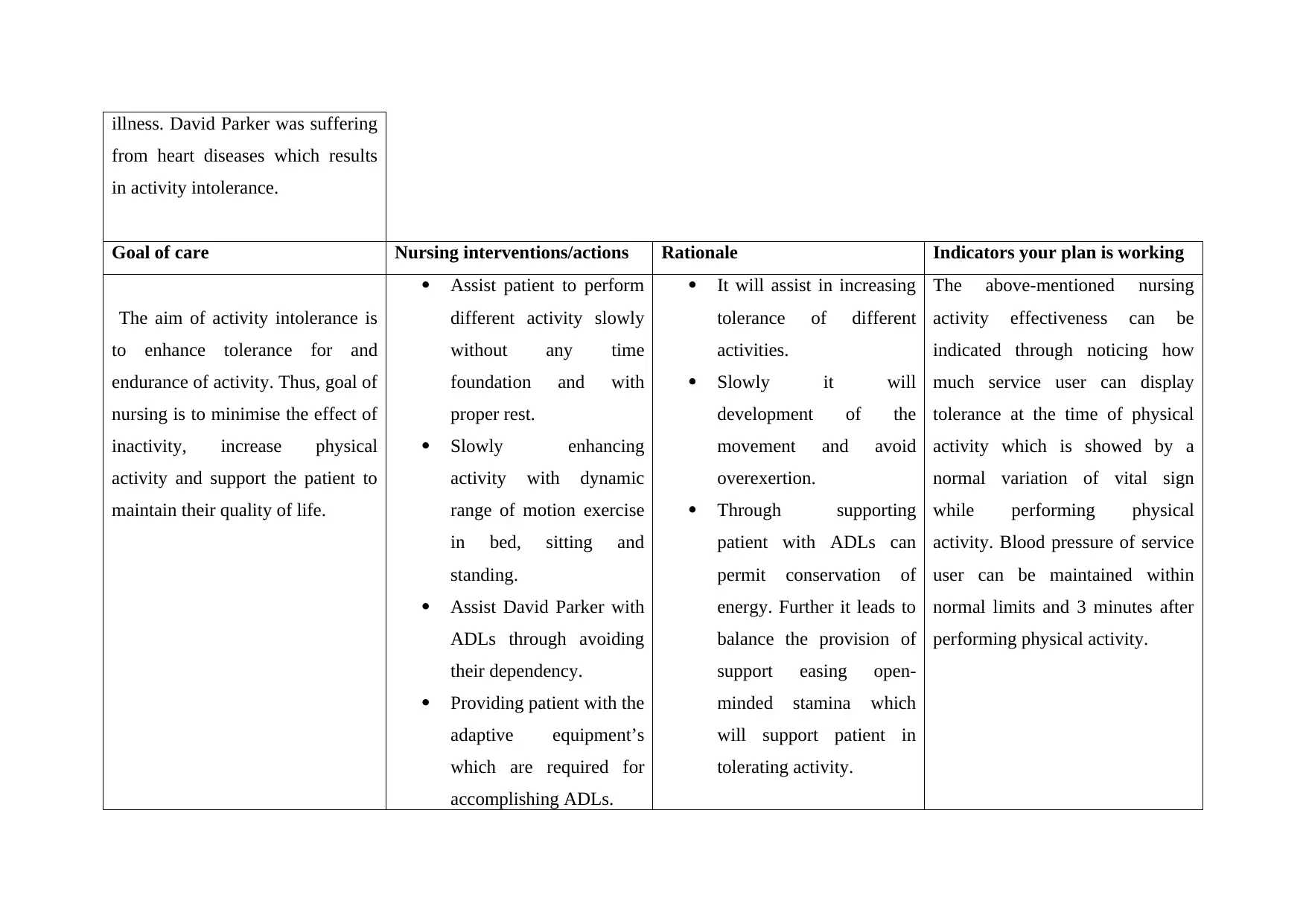
illness. David Parker was suffering
from heart diseases which results
in activity intolerance.
Goal of care Nursing interventions/actions Rationale Indicators your plan is working
The aim of activity intolerance is
to enhance tolerance for and
endurance of activity. Thus, goal of
nursing is to minimise the effect of
inactivity, increase physical
activity and support the patient to
maintain their quality of life.
Assist patient to perform
different activity slowly
without any time
foundation and with
proper rest.
Slowly enhancing
activity with dynamic
range of motion exercise
in bed, sitting and
standing.
Assist David Parker with
ADLs through avoiding
their dependency.
Providing patient with the
adaptive equipment’s
which are required for
accomplishing ADLs.
It will assist in increasing
tolerance of different
activities.
Slowly it will
development of the
movement and avoid
overexertion.
Through supporting
patient with ADLs can
permit conservation of
energy. Further it leads to
balance the provision of
support easing open-
minded stamina which
will support patient in
tolerating activity.
The above-mentioned nursing
activity effectiveness can be
indicated through noticing how
much service user can display
tolerance at the time of physical
activity which is showed by a
normal variation of vital sign
while performing physical
activity. Blood pressure of service
user can be maintained within
normal limits and 3 minutes after
performing physical activity.
from heart diseases which results
in activity intolerance.
Goal of care Nursing interventions/actions Rationale Indicators your plan is working
The aim of activity intolerance is
to enhance tolerance for and
endurance of activity. Thus, goal of
nursing is to minimise the effect of
inactivity, increase physical
activity and support the patient to
maintain their quality of life.
Assist patient to perform
different activity slowly
without any time
foundation and with
proper rest.
Slowly enhancing
activity with dynamic
range of motion exercise
in bed, sitting and
standing.
Assist David Parker with
ADLs through avoiding
their dependency.
Providing patient with the
adaptive equipment’s
which are required for
accomplishing ADLs.
It will assist in increasing
tolerance of different
activities.
Slowly it will
development of the
movement and avoid
overexertion.
Through supporting
patient with ADLs can
permit conservation of
energy. Further it leads to
balance the provision of
support easing open-
minded stamina which
will support patient in
tolerating activity.
The above-mentioned nursing
activity effectiveness can be
indicated through noticing how
much service user can display
tolerance at the time of physical
activity which is showed by a
normal variation of vital sign
while performing physical
activity. Blood pressure of service
user can be maintained within
normal limits and 3 minutes after
performing physical activity.
⊘ This is a preview!⊘
Do you want full access?
Subscribe today to unlock all pages.

Trusted by 1+ million students worldwide
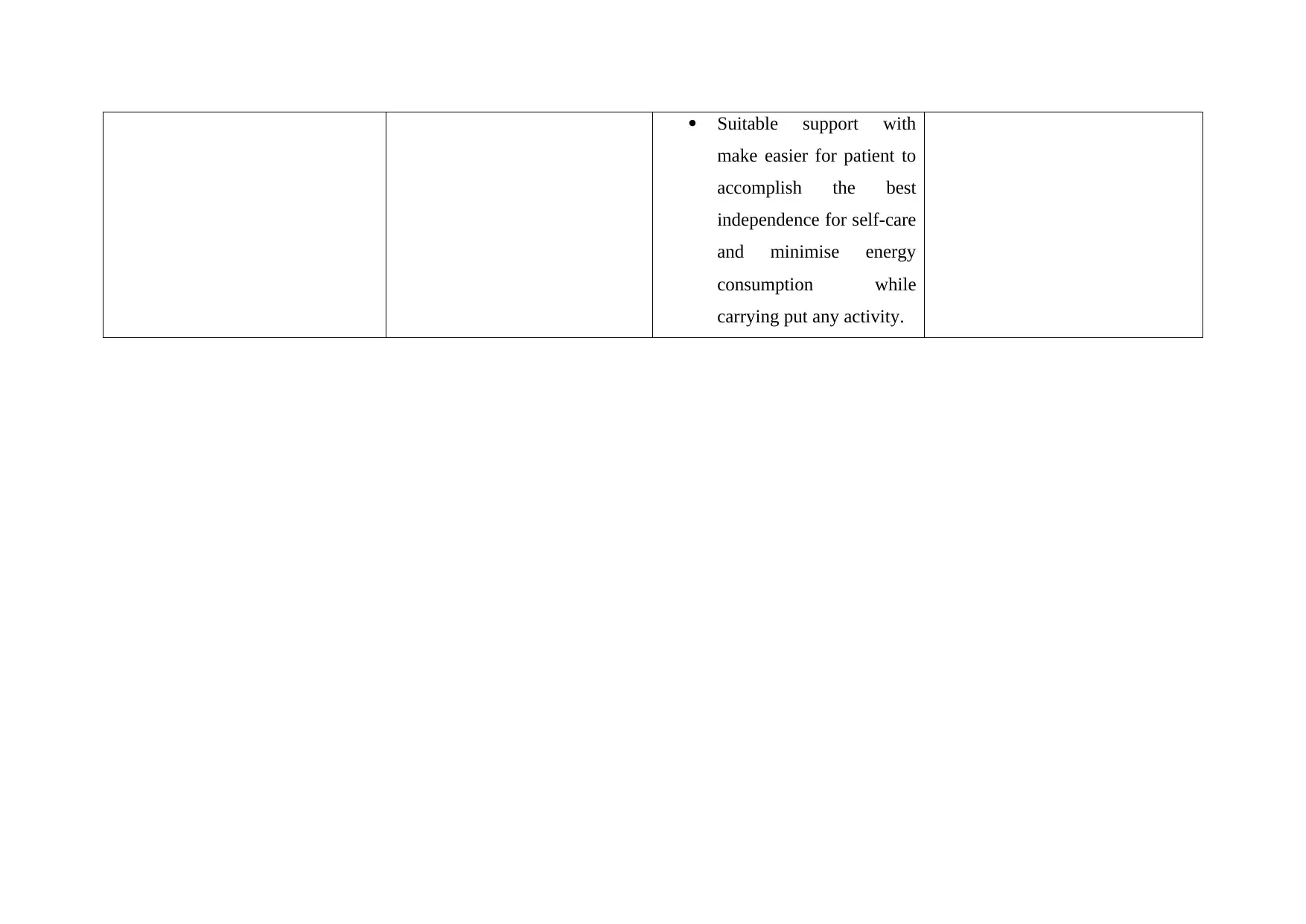
Suitable support with
make easier for patient to
accomplish the best
independence for self-care
and minimise energy
consumption while
carrying put any activity.
make easier for patient to
accomplish the best
independence for self-care
and minimise energy
consumption while
carrying put any activity.
Paraphrase This Document
Need a fresh take? Get an instant paraphrase of this document with our AI Paraphraser
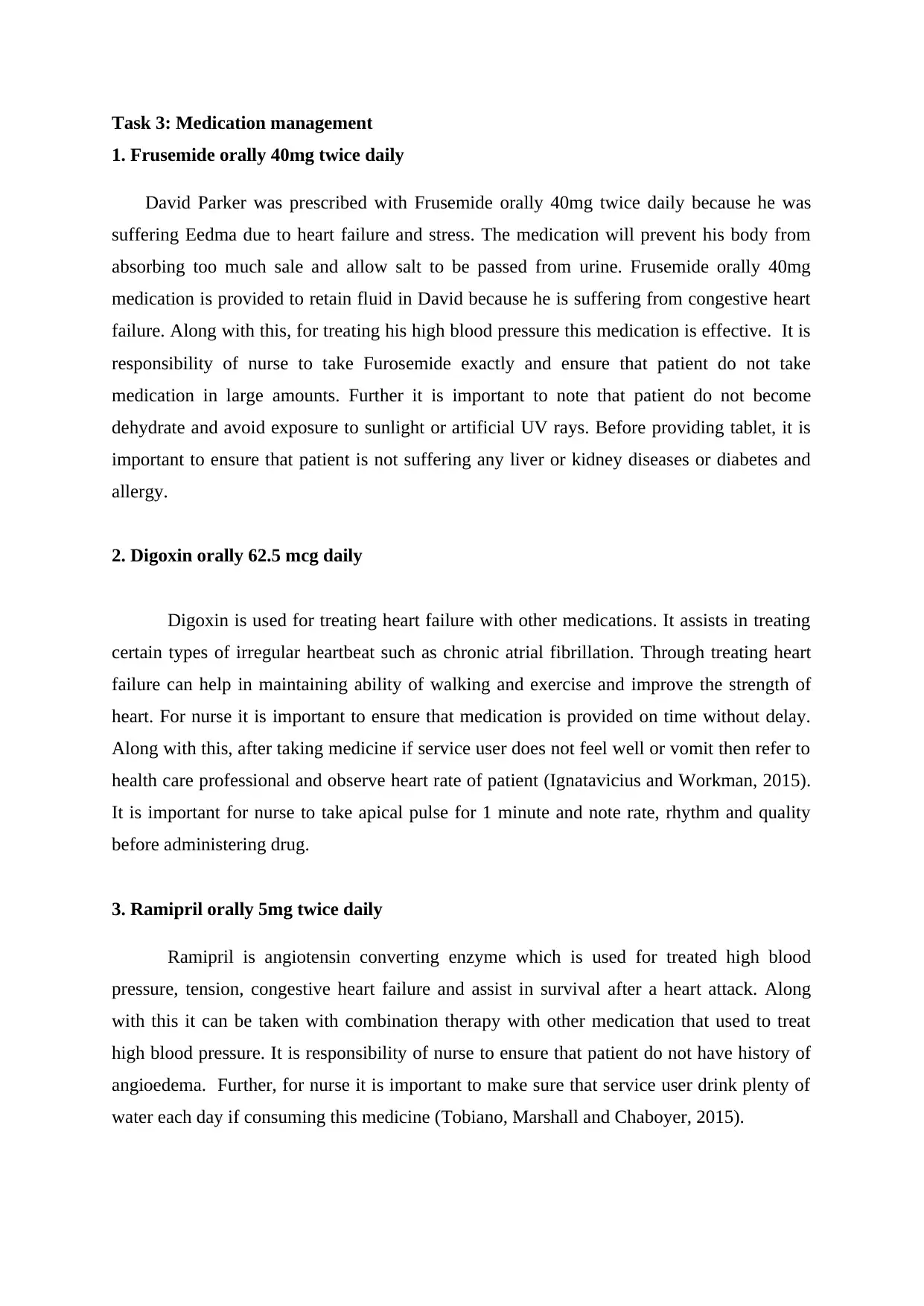
Task 3: Medication management
1. Frusemide orally 40mg twice daily
David Parker was prescribed with Frusemide orally 40mg twice daily because he was
suffering Eedma due to heart failure and stress. The medication will prevent his body from
absorbing too much sale and allow salt to be passed from urine. Frusemide orally 40mg
medication is provided to retain fluid in David because he is suffering from congestive heart
failure. Along with this, for treating his high blood pressure this medication is effective. It is
responsibility of nurse to take Furosemide exactly and ensure that patient do not take
medication in large amounts. Further it is important to note that patient do not become
dehydrate and avoid exposure to sunlight or artificial UV rays. Before providing tablet, it is
important to ensure that patient is not suffering any liver or kidney diseases or diabetes and
allergy.
2. Digoxin orally 62.5 mcg daily
Digoxin is used for treating heart failure with other medications. It assists in treating
certain types of irregular heartbeat such as chronic atrial fibrillation. Through treating heart
failure can help in maintaining ability of walking and exercise and improve the strength of
heart. For nurse it is important to ensure that medication is provided on time without delay.
Along with this, after taking medicine if service user does not feel well or vomit then refer to
health care professional and observe heart rate of patient (Ignatavicius and Workman, 2015).
It is important for nurse to take apical pulse for 1 minute and note rate, rhythm and quality
before administering drug.
3. Ramipril orally 5mg twice daily
Ramipril is angiotensin converting enzyme which is used for treated high blood
pressure, tension, congestive heart failure and assist in survival after a heart attack. Along
with this it can be taken with combination therapy with other medication that used to treat
high blood pressure. It is responsibility of nurse to ensure that patient do not have history of
angioedema. Further, for nurse it is important to make sure that service user drink plenty of
water each day if consuming this medicine (Tobiano, Marshall and Chaboyer, 2015).
1. Frusemide orally 40mg twice daily
David Parker was prescribed with Frusemide orally 40mg twice daily because he was
suffering Eedma due to heart failure and stress. The medication will prevent his body from
absorbing too much sale and allow salt to be passed from urine. Frusemide orally 40mg
medication is provided to retain fluid in David because he is suffering from congestive heart
failure. Along with this, for treating his high blood pressure this medication is effective. It is
responsibility of nurse to take Furosemide exactly and ensure that patient do not take
medication in large amounts. Further it is important to note that patient do not become
dehydrate and avoid exposure to sunlight or artificial UV rays. Before providing tablet, it is
important to ensure that patient is not suffering any liver or kidney diseases or diabetes and
allergy.
2. Digoxin orally 62.5 mcg daily
Digoxin is used for treating heart failure with other medications. It assists in treating
certain types of irregular heartbeat such as chronic atrial fibrillation. Through treating heart
failure can help in maintaining ability of walking and exercise and improve the strength of
heart. For nurse it is important to ensure that medication is provided on time without delay.
Along with this, after taking medicine if service user does not feel well or vomit then refer to
health care professional and observe heart rate of patient (Ignatavicius and Workman, 2015).
It is important for nurse to take apical pulse for 1 minute and note rate, rhythm and quality
before administering drug.
3. Ramipril orally 5mg twice daily
Ramipril is angiotensin converting enzyme which is used for treated high blood
pressure, tension, congestive heart failure and assist in survival after a heart attack. Along
with this it can be taken with combination therapy with other medication that used to treat
high blood pressure. It is responsibility of nurse to ensure that patient do not have history of
angioedema. Further, for nurse it is important to make sure that service user drink plenty of
water each day if consuming this medicine (Tobiano, Marshall and Chaboyer, 2015).
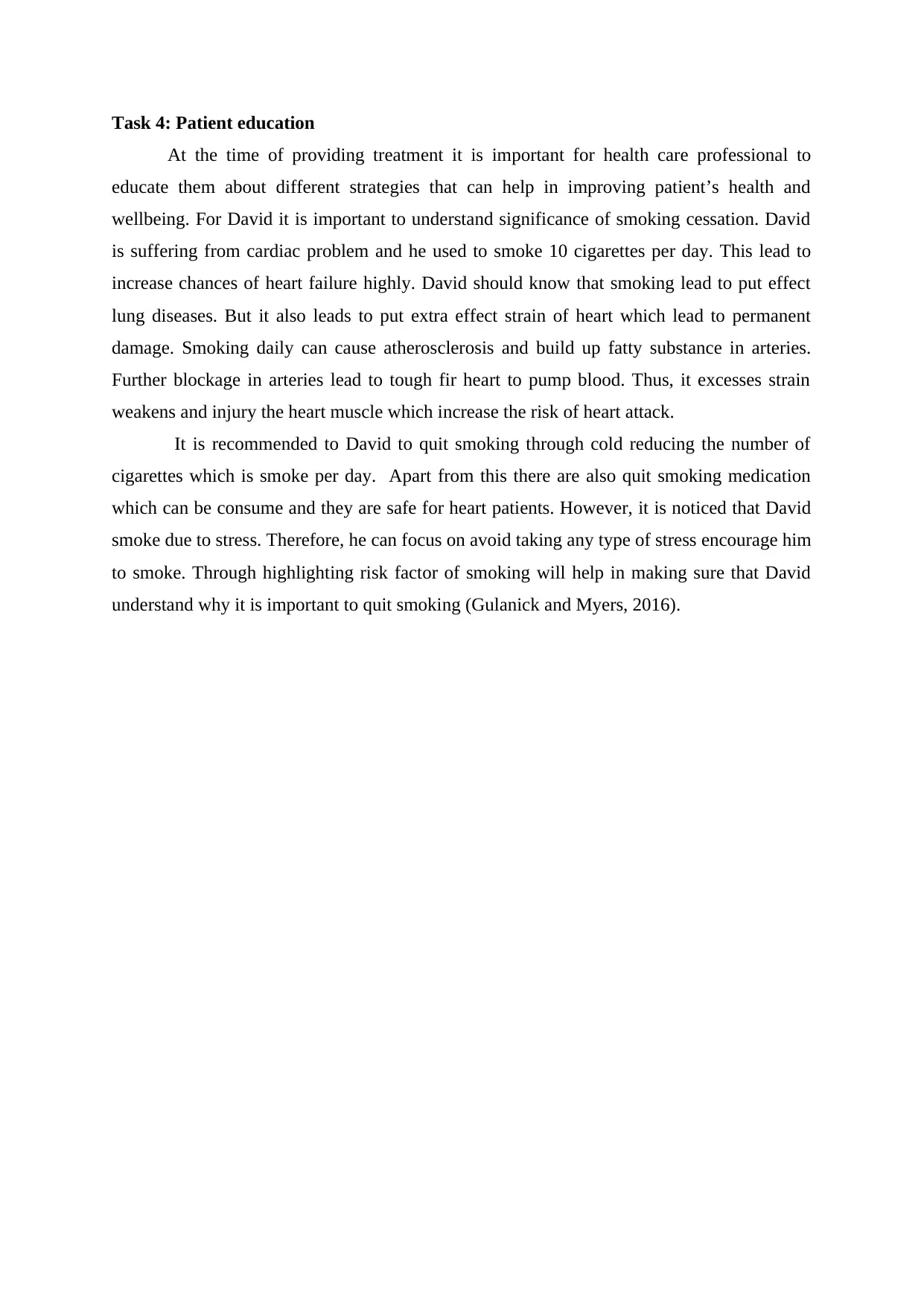
Task 4: Patient education
At the time of providing treatment it is important for health care professional to
educate them about different strategies that can help in improving patient’s health and
wellbeing. For David it is important to understand significance of smoking cessation. David
is suffering from cardiac problem and he used to smoke 10 cigarettes per day. This lead to
increase chances of heart failure highly. David should know that smoking lead to put effect
lung diseases. But it also leads to put extra effect strain of heart which lead to permanent
damage. Smoking daily can cause atherosclerosis and build up fatty substance in arteries.
Further blockage in arteries lead to tough fir heart to pump blood. Thus, it excesses strain
weakens and injury the heart muscle which increase the risk of heart attack.
It is recommended to David to quit smoking through cold reducing the number of
cigarettes which is smoke per day. Apart from this there are also quit smoking medication
which can be consume and they are safe for heart patients. However, it is noticed that David
smoke due to stress. Therefore, he can focus on avoid taking any type of stress encourage him
to smoke. Through highlighting risk factor of smoking will help in making sure that David
understand why it is important to quit smoking (Gulanick and Myers, 2016).
At the time of providing treatment it is important for health care professional to
educate them about different strategies that can help in improving patient’s health and
wellbeing. For David it is important to understand significance of smoking cessation. David
is suffering from cardiac problem and he used to smoke 10 cigarettes per day. This lead to
increase chances of heart failure highly. David should know that smoking lead to put effect
lung diseases. But it also leads to put extra effect strain of heart which lead to permanent
damage. Smoking daily can cause atherosclerosis and build up fatty substance in arteries.
Further blockage in arteries lead to tough fir heart to pump blood. Thus, it excesses strain
weakens and injury the heart muscle which increase the risk of heart attack.
It is recommended to David to quit smoking through cold reducing the number of
cigarettes which is smoke per day. Apart from this there are also quit smoking medication
which can be consume and they are safe for heart patients. However, it is noticed that David
smoke due to stress. Therefore, he can focus on avoid taking any type of stress encourage him
to smoke. Through highlighting risk factor of smoking will help in making sure that David
understand why it is important to quit smoking (Gulanick and Myers, 2016).
⊘ This is a preview!⊘
Do you want full access?
Subscribe today to unlock all pages.

Trusted by 1+ million students worldwide
1 out of 14
Related Documents
Your All-in-One AI-Powered Toolkit for Academic Success.
+13062052269
info@desklib.com
Available 24*7 on WhatsApp / Email
![[object Object]](/_next/static/media/star-bottom.7253800d.svg)
Unlock your academic potential
Copyright © 2020–2025 A2Z Services. All Rights Reserved. Developed and managed by ZUCOL.



